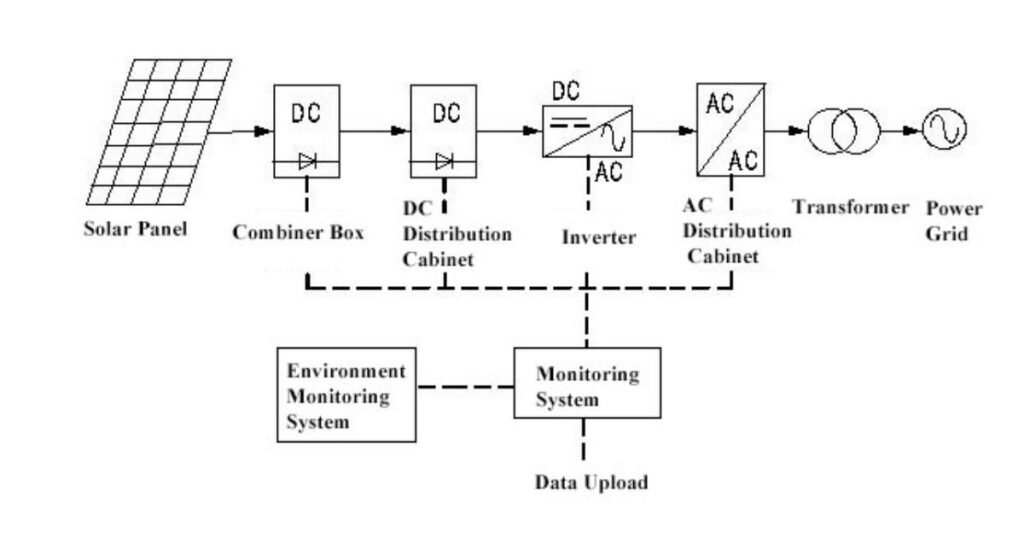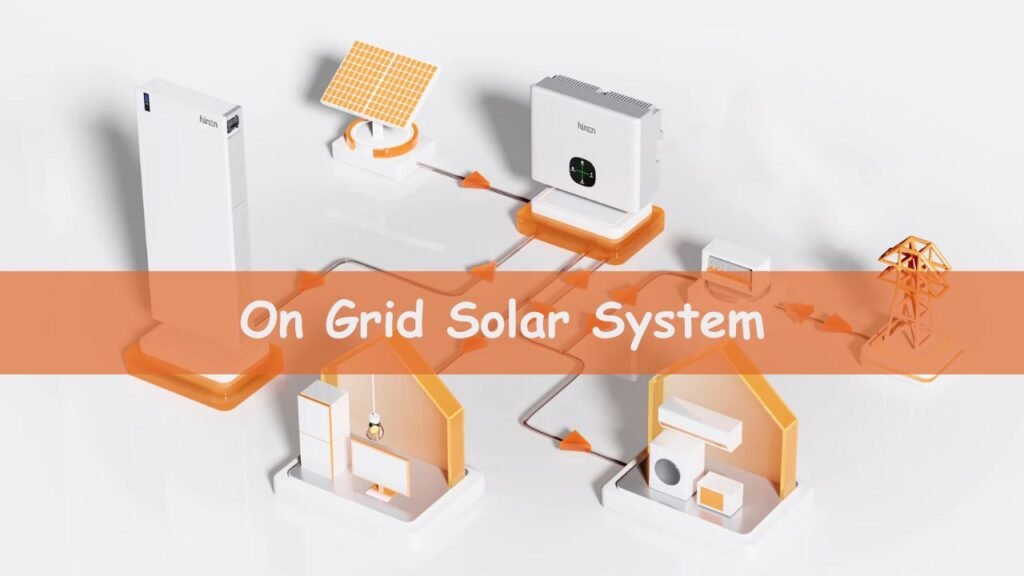Renewable energy is becoming increasingly popular. The use of solar technology in homes and businesses is on the increase in order to save money and save the planet. One of the most effective and feasible solutions is the on grid solar system. It delivers your solar panels directly into the primary power grid. This will enable you to utilize solar energy in the day and the grid at night or when it is cloudy. Let’s explore everything about this system, including how it works, its components, advantages, and installation process.
What is an On Grid Solar System?
An On grid solar system refers to a solar system that is connected to the power system. It uses solar panels to produce power using the sun. In the case of surplus energy, it is released to the grid. During periods of lower sunlight, the home uses electricity through the grid. It is also referred to as a solar on grid system or grid-tied system. It is best suited in locations where grid supply is consistent and assists in low power bills.
On Grid Solar System does not require batteries to store energy, as is the case with off-grid systems. This makes it less expensive, less heavy,y and less complicated to service. It is ideal in situations where the homeowner would not wish to spend much money, yet would not want to compromise grid reliability.
How the On Grid Solar System Works?
An on grid solar system can be worked easily but very efficiently. It converts solar energy to electrical energy, maintaining a constant power supply by controlling both the generation of energy and the consumption in the grid.
Step-by-Step Process
- Energy Generation: Solar panels absorb the sunlight and transform it into direct current (DC) electricity. These panels are fitted on rooftops or open spaces that have maximum exposure to sunlight.
- Conversion Process: The inverter converts the DC power into alternating current, which is utilized for the purpose of running household appliances and other electrical systems.
- Power Distribution: The AC electricity is converted to DC and utilized in the operating of appliances, lighting, and other electrical equipment within the house.
- Overproducing Power: The net metering allows any extra power produced by the panels to be channeled to the main grid. This excess energy will be credited to the homeowners, which lowers future bills.
- Grid Power: When the sun is low or at night, automatic power is acquired via the grid, and so power is never interrupted.
This simple cycle allows the system to operate smoothly without requiring expensive batteries.
Main Components of an On Grid Solar System

The solar on grid system has some essential components, and it is worth knowing them to determine their effectiveness. All the parts are very crucial in the generation and management of solar energy.
| Component | Purpose and Function |
| Solar Panels | Capture sunlight and convert it into DC power. |
| Inverter | Converts DC into usable AC electricity. |
| Net Meter | Measures electricity sent to and drawn from the grid. |
| Mounting System | Holds panels securely on roofs or the ground. |
| Grid Connection | Link your system to the utility grid for power exchange. |
Solar Panels
In an on-grid solar system, solar panels are the main energy generation device. They are made up of photovoltaic (PV) cells which convert sunlight to DC electricity. Three types are used, namely, monocrystalline, polycrystalline, and thin-film. Monocrystalline panels are the most efficient, whereas polycrystalline panels are affordable and long-lasting. Thin-film panels are not efficient enough, but can be used in some roof types as they are light and flexible.
Inverter
The inverter is the most crucial part of the on grid solar system. It transforms the DC energy generated by solar panels to AC energy which is consumed by domestic appliances. Solar electricity can not be effectively used without the inverter.
Inverters are of different types: string inverters (for residential setups), microinverters (connected to individual panels for better performance), and central inverters (for large installations). The inverter ensures safe, stable, and continuous power conversion.
Net Meter
A net meter monitors the electricity flow between your system and the grid. It records both the power generated and sent to the grid, as well as the electricity consumed from it. If you produce more electricity than you use, you earn credits from your utility company, helping you save more on your bills. One of the greatest benefits associated with the on grid solar system is Net metering, which has a financial benefit in the long run.
Mounting Structure
The mounting systems have been structured in such a way that they ensure that the solar panels are firmly attached. Roof mounting constructions are perfect to be used in residential buildings because it does not consume much space, whereas ground mounting is used in large buildings and commercial installations. These constructions make sure that panels are oriented towards the sun in the most optimal way of generating the amount of energy and can withstand changes in the weather.
Advantages of On Grid Solar System
There are several advantages of using this system, both for homeowners and businesspeople. Let us look at the major benefits that make it a favorite among all at the global level.
1. Cost-Effective Setup
The system does not use batteries, hence at a minimal cost of installing it. This renders it a cost-effective solution to homeowners wishing to make the transition to solar without making huge expenditure.
2. Continuous Power Supply
By keeping in touch with the main grid you have an uninterrupted power supply. When the sun goes down behind the clouds or at night, the grid electricity automatically supplies your home when the sun is not producing the required amount of solar power.
3. Net Metering Benefits
It is possible to sell the surplus energy to the grid, which is one of the largest benefits. You are rewarded with a bill credit or even a lower bill, depending on the amount of electricity you contribute through net metering.
4. Eco-Friendly Energy
The on grid solar system makes use of sunlight, which is a clean, renewable source of energy. It will decrease the reliance on fossil fuels, will minimize carbon emissions, and contribute to a sustainable future.
5. Low Maintenance
The design of the system is also easy and does not demand maintenance often. Solar panels should be cleaned periodically, and inverters should be checked occasionally to ensure that it is efficient.
Disadvantages of the On Grid System
Though efficient, on grid solar systems have some drawbacks.
- Grid dependency means that when there is an outage in power, your solar system also stops working because it’s connected to the grid.
- No Energy Storage: Solar power cannot be utilized during an outage without a battery backup.
- Less independence: You still depend partly on the main grid.
Despite these issues, it remains the most cost-effective and practical choice for urban homes.
Financial Benefits and Government Incentives
Governments encourage solar adoption by providing financial support to homeowners and businesses. Let’s see some of the most common benefits associated with installing an on grid solar system.
| Benefit Type | Description |
| Subsidy | Many regions offer up to 40% subsidy on installation costs. |
| Tax Credit | Homeowners can claim deductions for renewable energy use. |
| Return on Investment | Most systems recover their cost within 4–6 years. |
| Net Metering | Provides savings or credits for the energy sent to the grid. |
These incentives make solar energy more affordable and accessible for everyone.
Installation Process of an On Grid Solar System
Installing an on-grid solar system is a structured process that ensures safety and efficiency.
- Step 1: A site inspection is conducted to analyze sunlight direction, roof angle, and available space.
- Step 2: Experts design a customized solar system based on your energy requirements.
- Step 3: Solar panels, inverter, and wiring are installed carefully.
- Step 4: The system is tested for safety and approved by local authorities.
- Step 5: Once connected, it starts generating electricity instantly.
Proper installation by certified professionals ensures optimal performance and long-term reliability.
Maintenance Tips for Better Performance
To keep your on-grid solar system working efficiently, follow these tips:
- Clean panels monthly to remove dust.
- Keep inverter areas dry and clean.
- Track performance using a solar monitoring app.
- Schedule annual inspections by experts.
Consistent maintenance ensures longevity and maximum energy output.
Conclusion:
The on grid solar system is a smart, eco-friendly, and cost-effective solution for homes and businesses seeking sustainable power. It ensures constant electricity, lowers bills, and promotes environmental conservation. With government incentives and easy installation, it’s one of the best investments for a cleaner and more energy-efficient future. Switching to an on-grid solar system today means investing in long-term savings and contributing to a brighter, greener world.
Also Read About: Off Grid Solar System Costs and Details in India
